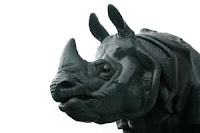Black or White? Carved Rhino Horns Sold at Auction, Targeted for Forfeiture
The government writes in its May 21st complaint, “The price of libation cups made from rhinoceros horns has increased greatly in recent years.” They are highly coveted in a “thriving black market” as rhinos continue to face extinction.
Federal prosecutors allege I.M. Chait Gallery featured the carved horns on the cover of the gallery’s catalog for the 2011 Asian and International Fine Arts Auction. The pieces were described as Chinese, “PAIR ANTIQUE CARVED RHINO HORN VESSELS.” The gallery claimed that the objects were made from a white rhinoceros, according to the complaint.
U.S. Fish and Wildlife (USFWS) investigated the horns as the shipper prepared the objects for delivery. Export paperwork listing confused information about age (“antique” but “less than 100 years old”) and species identification (white rhinoceros) led authorities to test the items. The National Fish and Wildlife Forensics Laboratory “positively identified them as carved from black rhinoceros (Diceros bicornis) horn.”
The black rhinoceros is listed among the most protected endangered species in the appendix of the Convention on International Trade in Endangered Species. That treaty is implemented in the U.S. by the ESA.
Federal prosecutors explain that “a special agent of the USFWS received a voicemail message from I.M. Chait, who stated, in substance, that he was not certain what species of rhinoceros horn the carvings were made from, [and that] he (Chait) knew they were 200 years old, and therefore considered antique.” The government adds to its complaint that “I.M. Chait further stated that since the carvings were antique, the specific rhinoceros species should not matter.”
The buyer contacted authorities to explain, “Had I known these are the Black Rhinoceros Carvings, I would never never have risked my hard earned money from my personal savings (over $200,000) to buy them. . . . I would really appreciate if you could return these items to me. However, I am also comfortable to keep these items in US as my personal collection in [the] future in case you and US Customs think they can’t be shipped out of US. But to confiscate them will be devastating to my personal finance and my life in general.”
Photo credit: mordoc
This post is researched, written, and published on the blog Cultural Heritage Lawyer Rick St. Hilaire at culturalheritagelawyer.blogspot.com. Text copyrighted 2010-2013 by Ricardo A. St. Hilaire, Attorney & Counselor at Law, PLLC. Any unauthorized reproduction or retransmission of this post is prohibited. CONTACT INFORMATION: www.culturalheritagelawyer.com


